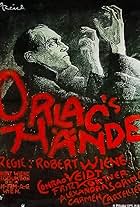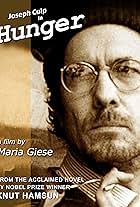After the Nobel prize winning Knut Hamsun-novel, with it's criticism of industrialization, urbanizing and loss of values. The farmer Isak makes a farm out of barren soil, together with Inger... Read allAfter the Nobel prize winning Knut Hamsun-novel, with it's criticism of industrialization, urbanizing and loss of values. The farmer Isak makes a farm out of barren soil, together with Inger and their two sons. She kills the third.After the Nobel prize winning Knut Hamsun-novel, with it's criticism of industrialization, urbanizing and loss of values. The farmer Isak makes a farm out of barren soil, together with Inger and their two sons. She kills the third.
Photos
Karen Poulsen
- Inger
- (as Karen Thalbitzer)
- Director
- Writers
- All cast & crew
- Production, box office & more at IMDbPro
Storyline
Did you know
- TriviaThe movie had been lost for half a century until a 60 minutes copy was found in New York in 1971. Twenty years later, in 1991, a more complete version appeared in the Netherlands, where the movie was restored one year later. The second and most recent restoration was undergone in Norway in 2009, after which the film was released on DVD. The present edition is a little more than 90 minutes long, but there're 20, or even 30 minutes of footage that are still missing.
Featured review
Based on a wildly popular novel of 1917 (the author Knut Hamsun was awarded the Nobel prize for literature for the book in 1920) this film was, for many years, considered 'lost' until an incomplete copy turned up in New York. In 1991 another copy came to light in the Dutch Film Museum. Most of the film was recreated from these two incomplete prints. A full orchestral accompaniment had been composed by composer Leif Halvorsen for its initial release and a copy of the score was found in 1994 in the Norewegian Broadcasting Corperation's archives where it had been sitting on a shelf for forty years.
Synopsis: Isak, a middle-aged wanderer, builds himself a homestead in the middle of the wilderness. Eventually he is joined by Inger who is described in a caption as "comely" but disfigured with a hare lip. Together they tame the wilderness and have three children. Two boys and a girl. The girl is is born with a hare lip and Inger kills and buries her. The burial is seen by Oline, a less than nice neighbour, who spreads the news. Eventually Inger is tried and convicted to eight years in prison, little realising she is again already pregnant.
Isak is heartbroken but continues to bring up his two sons. He sells some of his land to a copper mining company and becomes relatively wealthy. More settlers buy land around the homestead. Inger is released after eight years and returns home with the daughter she has born while in jail.
The action then switches to the next generation, Barbro, the daughter of a neighbour, and Axel, a strapping lad with a beard, get together. She then learns that her Axel is taking a job that rightfully belongs to her father. She falls into a river while in labour and the baby dies. She is tried for murder in 'the city'. Meanwhile her husband stupidly manages to get himself trapped under a falling tree. He calls for help. The only person within earshot is Barbro's father (why neither of these two is in the city at the trial is not explained) The Father walks on by leaving Axel to die. Barbro is acquitted, and returns home to find her husband still alive under the tree. She goes and gets Isak to help. He pulls Axel free and the pair are reconciled. There is a wedding and Isak and Inger slip away to look at the sky and wonder at the marvels of nature and the rural idyll that they have created.
The first part of the film is straightforward linear narrative and its simple story is easy to follow. Stilted, slow, and clumsy it may seem to today's eyes (there were sniggers and laughs at some of the captions in the showing I was at) but there is a simple honesty here that rewards the viewer. The camera is solidly placed and, apart from the odd pan and the occasional iris to black, pretty square-on to the action. The acting is never over the top or melodramatic, the filming is direct and almost documentary like, the staging often clumsy and fumbled. (Indeed I can't recall having seen a film in which I spent so much time looking at peoples' backs as this one.) It all gives the film a sense of reality that is refreshing. The moment where Inger gently rolls the turf back over the shallow grave of the child like a blanket is done with such tenderness and simplicity it makes it a beautiful, genuinely moving moment.
The latter part of the film after Inger's return is more confusing and, I suspect, is suffering more lost footage than the first part*. There is a strike at the mine, we see workers leaving, and shaking their fists in anger, then - nothing, no further mention is made of the strike or the mine for the rest of the film. And it may be my ignorance of the social structure of Norway at the time but it seems odd that Barbro and Axel get married _after_ she has already had one child by him. And I still can't work out how long Axel was supposed to have been under that tree. Several days I think.
There is one great moment in this film where the director breaks free of his static shots and slow pans. As Axel is lying under the tree the camera slowly dollies in on the lamp Barbro has left by his side and there is an extraordinary little montage of scudding clouds and faces before the camera pulls back out again in reverse. There were moments towards the end where I was reminded of John Ford's movies, especially the shot where we see Isak and Inger through the open doorway slipping away from the party - I wonder if he ever saw it?
I saw this film projected with an 28 piece orchestra performing the music - the first time I have ever seen 'silent' film as it was meant to be seen. It was an interesting experience that I would recommend to anyone remotely interested in the history of film.
*The Norwegian Film Institute (and the IMDb) list this as running at 107 minutes (2426 meters) The recreated version I saw tonight ran at 93 minutes so there are 14 or so minutes still missing.
Synopsis: Isak, a middle-aged wanderer, builds himself a homestead in the middle of the wilderness. Eventually he is joined by Inger who is described in a caption as "comely" but disfigured with a hare lip. Together they tame the wilderness and have three children. Two boys and a girl. The girl is is born with a hare lip and Inger kills and buries her. The burial is seen by Oline, a less than nice neighbour, who spreads the news. Eventually Inger is tried and convicted to eight years in prison, little realising she is again already pregnant.
Isak is heartbroken but continues to bring up his two sons. He sells some of his land to a copper mining company and becomes relatively wealthy. More settlers buy land around the homestead. Inger is released after eight years and returns home with the daughter she has born while in jail.
The action then switches to the next generation, Barbro, the daughter of a neighbour, and Axel, a strapping lad with a beard, get together. She then learns that her Axel is taking a job that rightfully belongs to her father. She falls into a river while in labour and the baby dies. She is tried for murder in 'the city'. Meanwhile her husband stupidly manages to get himself trapped under a falling tree. He calls for help. The only person within earshot is Barbro's father (why neither of these two is in the city at the trial is not explained) The Father walks on by leaving Axel to die. Barbro is acquitted, and returns home to find her husband still alive under the tree. She goes and gets Isak to help. He pulls Axel free and the pair are reconciled. There is a wedding and Isak and Inger slip away to look at the sky and wonder at the marvels of nature and the rural idyll that they have created.
The first part of the film is straightforward linear narrative and its simple story is easy to follow. Stilted, slow, and clumsy it may seem to today's eyes (there were sniggers and laughs at some of the captions in the showing I was at) but there is a simple honesty here that rewards the viewer. The camera is solidly placed and, apart from the odd pan and the occasional iris to black, pretty square-on to the action. The acting is never over the top or melodramatic, the filming is direct and almost documentary like, the staging often clumsy and fumbled. (Indeed I can't recall having seen a film in which I spent so much time looking at peoples' backs as this one.) It all gives the film a sense of reality that is refreshing. The moment where Inger gently rolls the turf back over the shallow grave of the child like a blanket is done with such tenderness and simplicity it makes it a beautiful, genuinely moving moment.
The latter part of the film after Inger's return is more confusing and, I suspect, is suffering more lost footage than the first part*. There is a strike at the mine, we see workers leaving, and shaking their fists in anger, then - nothing, no further mention is made of the strike or the mine for the rest of the film. And it may be my ignorance of the social structure of Norway at the time but it seems odd that Barbro and Axel get married _after_ she has already had one child by him. And I still can't work out how long Axel was supposed to have been under that tree. Several days I think.
There is one great moment in this film where the director breaks free of his static shots and slow pans. As Axel is lying under the tree the camera slowly dollies in on the lamp Barbro has left by his side and there is an extraordinary little montage of scudding clouds and faces before the camera pulls back out again in reverse. There were moments towards the end where I was reminded of John Ford's movies, especially the shot where we see Isak and Inger through the open doorway slipping away from the party - I wonder if he ever saw it?
I saw this film projected with an 28 piece orchestra performing the music - the first time I have ever seen 'silent' film as it was meant to be seen. It was an interesting experience that I would recommend to anyone remotely interested in the history of film.
*The Norwegian Film Institute (and the IMDb) list this as running at 107 minutes (2426 meters) The recreated version I saw tonight ran at 93 minutes so there are 14 or so minutes still missing.
- junk-monkey
- Feb 11, 2006
- Permalink
Details
- Release date
- Country of origin
- Language
- Also known as
- Bendición de la Tierra
- Filming locations
- Production companies
- See more company credits at IMDbPro
Box office
- Budget
- NOK 250,000 (estimated)
- Gross worldwide
- $4,272
- Runtime1 hour 15 minutes
- Color
- Sound mix
- Aspect ratio
- 1.33 : 1
Contribute to this page
Suggest an edit or add missing content





